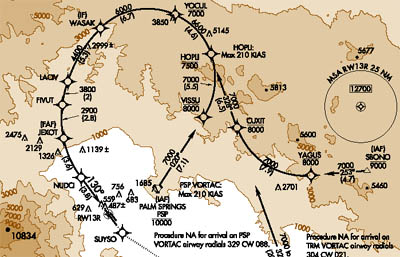A while back, I made a casual suggestion John at Aviation Mentor. He often writes about instrument flying in “glass panel” aircraft, something that is near and dear to my heart since this is one of my specialties at work.
I’d been noticing that more and more instrument approach procedures where being developed with weird minima.  There were columns for LNAV, LNAV/VNAV, RNP, LPV, and more. Back in the late 90’s when I got my instrument rating, these acronyms weren’t even a gleam in the eye of their creator. Now they’re all over the place, and CFIIs have to ensure their students know what these things mean.
I’ll let John take it from there. Read his article and tell me it doesn’t sound confusing. LNAV/+V? C’mon people. The FAA and equipment manufacturers can’t even agree on whether or not an LPV approach is “precision” or “non-precision”.
I’m glad I suggested this as a topic. One observation I have on the whole LNAV/VNAV thing is that in the past, when new approach capabilities were introduced to the IFR world, the equipment was usually in place at or before the time when the approaches starting appearing. For some reason, it’s backwards this time. There are a ton of RNAV approaches with VNAV glideslopes depicted on the plate, yet as far as I know, very few — if any — aircraft are yet certified to fly them.
Since the approaches have to be tested before they’re approved for the general public, I wonder if the FAA is the only one with the capability to fly these things. John indicates that he hasn’t flown any VNAV capable equipment yet. I haven’t either, nor do I know anyone who has done so in the soup. Between the two of us, we’re operating in the largest metropolitan areas in the state of California.
I completely agree with his concerns about the way this capability is being integrated into our cockpits. The terminology is confusing, and it’s a terrible idea to have a pilot approaching a final approach fix without an idea of whether he’ll be shooting a precision or non-precision approach.
If the GPS receiver decides it doesn’t have the required geometry for a glideslope approach, the downgrade is annunicated at the worst possible moment. There is no more likely time for a pilot to miss a flashing message light than when he’s about to pass the final approach fix. ATC is providing final vectors, issuing an approach clearance, approach mode should be armed/arming, the pilot is running the “T”s and the Before Landing checklist.
I’ve always had a suspicion that these things were developed and tested in a perfect-world environment, something that those of us in busy airspace never see. People who can afford a $65,000 glass panel are not aviating in the middle of nowhere, they’re flying in busy metropolitan areas and mixing it up with large jets and controllers who vector them as close as possible to the final approach fix.
The lack of a glideslope is not enough of an indicator; glideslopes fail for more than one reason. Is it a software bug? Did we load the wrong approach? Or fail to activate it? Is there a hardware problem?  A RAIM alert? This is not a good place for head-down time and button pushing. These things should be designed to minimize that, not maximize it.
It seems to me it might be better to make critical annunciations more obvious to the pilot. A tiny flashing “message” in the lower corner of nearly four square feet of computer screens is not sufficient. My students miss these annunications all the time. In fact, they actually learn to ignore them because most of the annunciations are nuisance alerts. Airspace, schedulers, etc.
Pilots need to preconfigure the avionics suite so messages are minimized. That means understanding the auxillary and setup pages. We also need better education on GPS approaches. If you fly a TSO-129 GPS equipped aircraft, you own it to yourself to read AIM 1-1-19, 1-2, 5-4-5(d), and other related sections of the Aeronautical Information Manual
A logical system for integrating new approach technologies without just throwing new acronyms and minima onto hundreds of approach plates would go a long way toward preparing pilots before the approaches were out there. From my experience, it’s easy enough for a pilot to inadvertently select the wrong minimums without adding all these new ones to the mix.

One look at an RNP approach (like the one above, from Palm Springs) should be enough to convince anyone of the capability GPS can provide.  But those who don’t have an airline training department and budget behind them must proceed with caution, lest the road to GPS nirvana turn into GPS hell.
